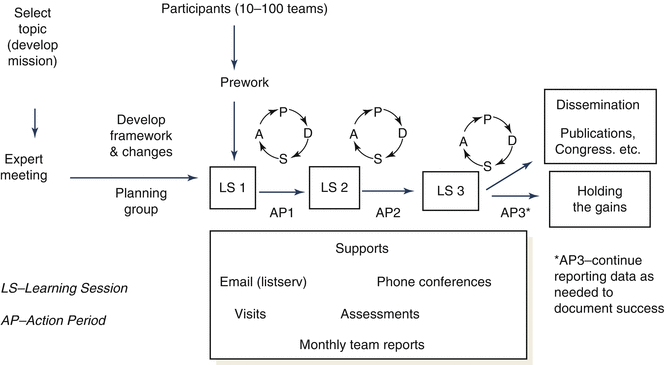Fig. 4.1
NPC-QIC key driver diagram
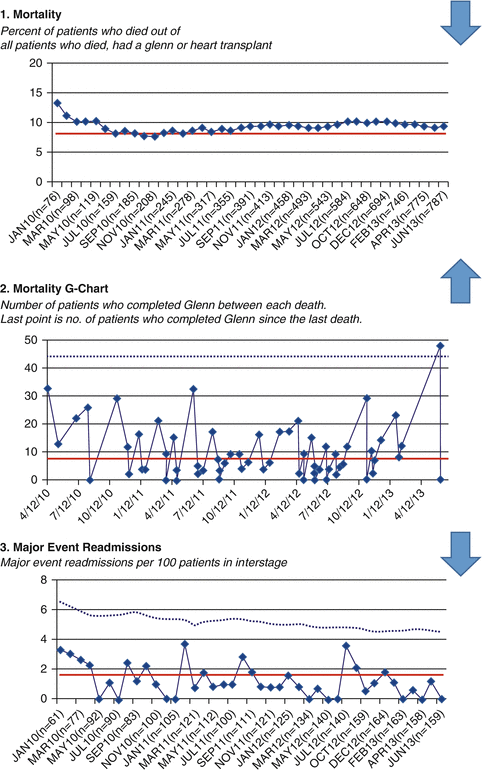
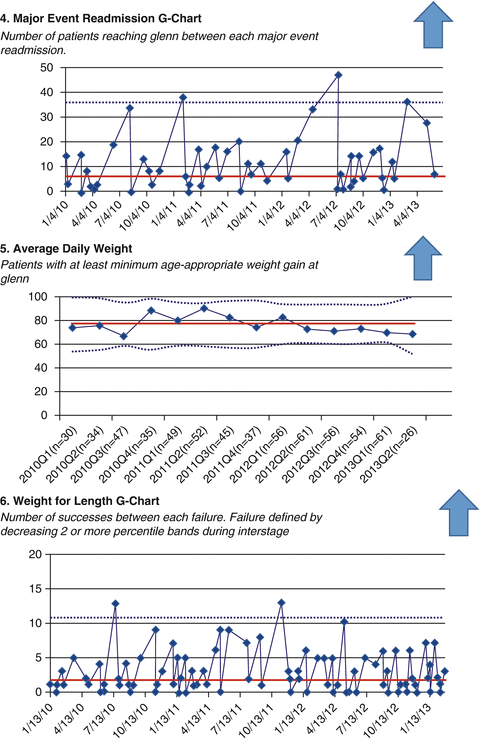
Fig. 4.2
NPC-QIC outcome measures
Team Recruitment
An initial group of six teams from clinical sites that perform stage 1 Norwood palliation were used to pilot test the data collection forms. A secure electronic database (REDCap) using a web-based interface was created for data collection. The sites collected visit-specific information at the individual patient level from stage 1 and stage 2 hospitalizations, interstage clinic visits and any interstage readmissions. This information included data regarding care processes as well as clinical outcome data. After the pilot testing with the initial six teams, all sites were invited to participate through an invitation circulated through the American Academy of Pediatrics Section on Cardiology and Cardiac Surgery, as well as multiple presentations at pediatric cardiology meetings. The data forms have been reviewed, updated, and revised at regular intervals to ensure accuracy and usability. In the first 3 years NPC-QIC has grown to over 40 sites in the United States (Fig. 4.3).
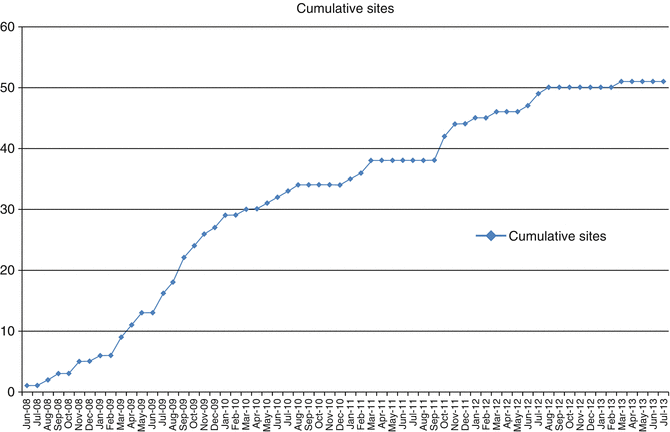

Fig. 4.3
Growth of number of NPC-QIC sites over time
Collaborative structure
The collaborative is a longitudinal learning community that used the Institute for Healthcare Improvement’s Breakthrough Series (BTS) Model [36–40]. The BTS model is a change management platform that utilizes effective dissemination and behavior change tools to support practice changes [41]. The BTS methods are based on educational, statistical, and systems theory. These include: (1) a focus on shared goals that are clear and explicit so that teams are aligned along a common purpose; (2) the use of data and feedback to allow teams to identify opportunities for individual improvement; and (3) the use of aggregate data, face-to-face meetings, and individual coaching to engage teams in working together to improve the systems of care for patients. The components of the BTS can be seen in Fig. 4.4 [42].
Pediatric cardiology centers participate as teams comprised of a physician champion, nursing and administrative representatives, and a nutritionist. Teams are also encouraged to include a parent or family representative. Each month, the teams collect data on patient status and care processes; post reports of their progress; participate in webinars and a listserv; and, test changes to improve their systems. Semi-annual “learning sessions” which are 1–2 day workshops bring teams together to share lessons learned. Pediatric cardiologists provide content expertise and project staff support teams as needed, particularly with implementation of changes in practice. Parents were involved in the design and implementation of the network, and work actively with clinical team member–in research work groups, at the semi-annual meetings and monthly webinars, and where aggregate data are reviewed and barriers to improvement are discussed. The NPC-QIC has encouraged and facilitated the development of parent groups at each clinical site. Clinical teams and parents have together developed practical tools (e.g. feeding algorithms, video about discharge planning, ‘red flag’ checklists).In addition, along with education and support of quality improvement activities, parent-led presentations and parent panels are key components of the learning sessions. Primary care clinicians have also participated in the learning sessions and provide insight into the challenges in child handovers and coordination of care between sub-specialists and primary medical homes for these complex patients. The Anderson Center for Health Systems Excellence at Cincinnati Children’s Hospital Medical Center provided the improvement, project management and data infrastructure for the NPC-QIC project. The Center has supported over 45 collaborative multi-site improvement projects involving more than 1,500 organizations [43–45].
Outcomes
One of the key findings from the NPC-QIC was the considerable variation in management and outcomes of infants with hypoplastic left heart syndrome [46–48]. This management variation was seen at several points along the process of care including pre- and post-operatively, after the Norwood procedure, as well as during the outpatient interstage. NPC-QIC has facilitated the sharing of best practices among participating centers using face-to-face meetings called Learning Sessions and monthly webinars called Action Period Calls. There has been significant improvement in and standardization of the NPC-QIC process measures as these practices have been implemented, including at additional centers. These measures capture important clinical processes at the time of discharge following the Norwood procedure and during the interstage clinic visits. Examples of improvement in process measures can be found in Fig. 4.5.
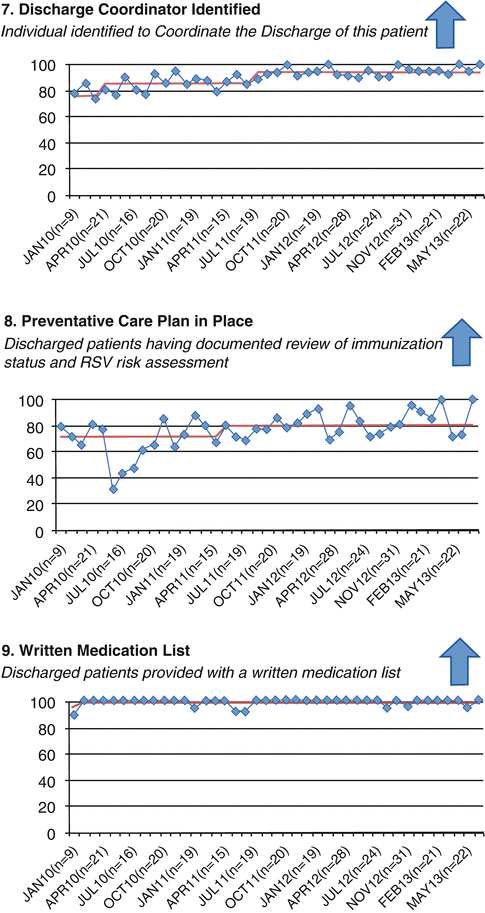
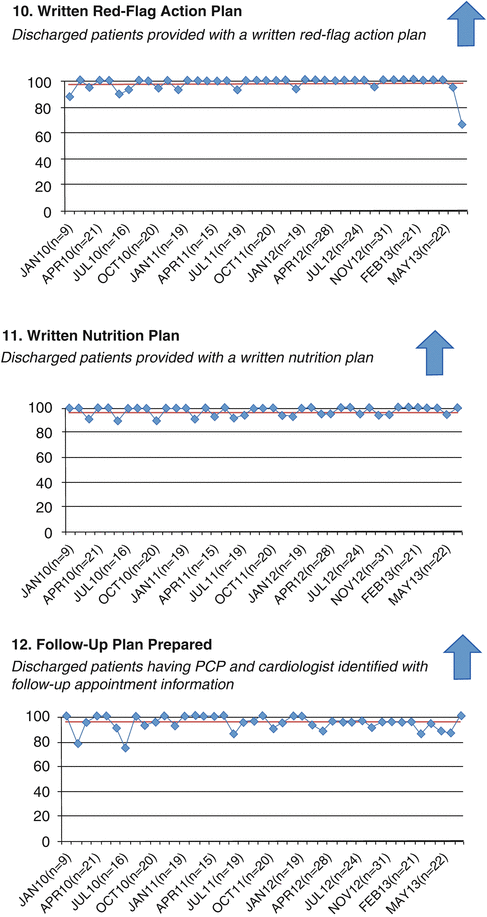
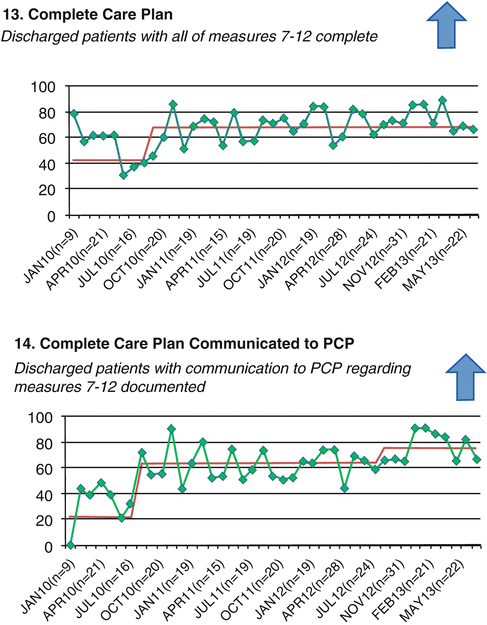
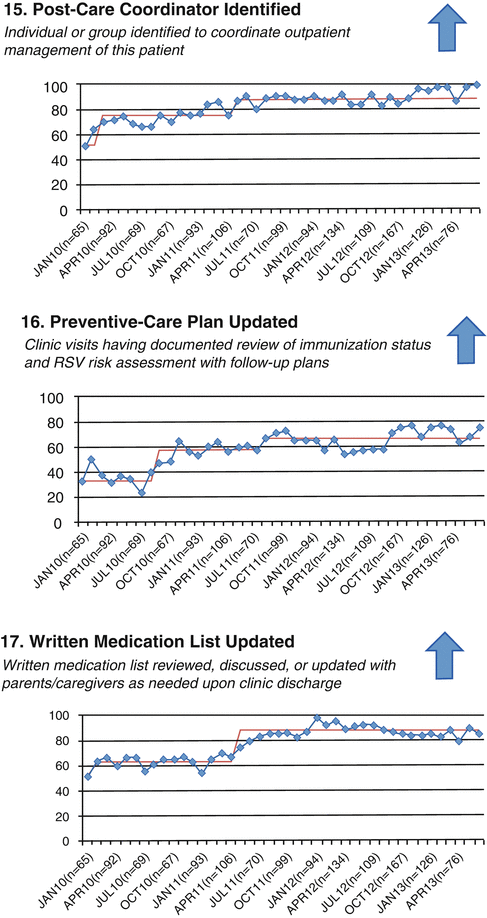
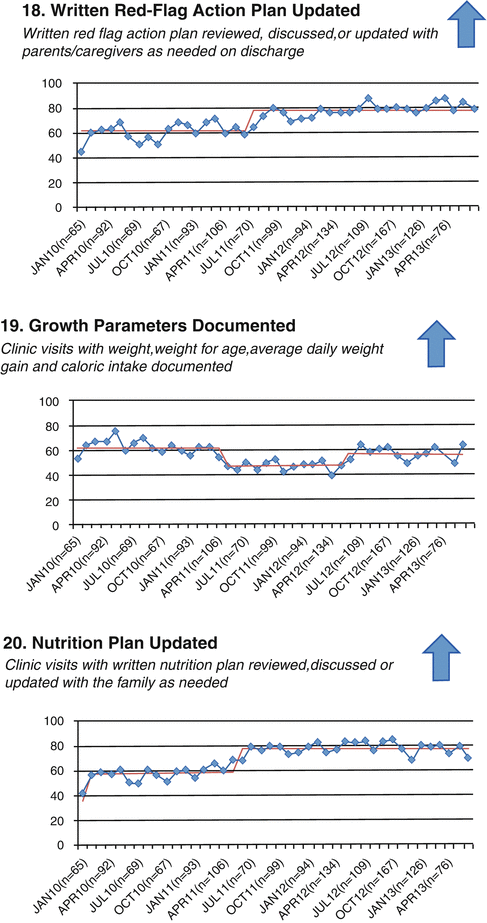
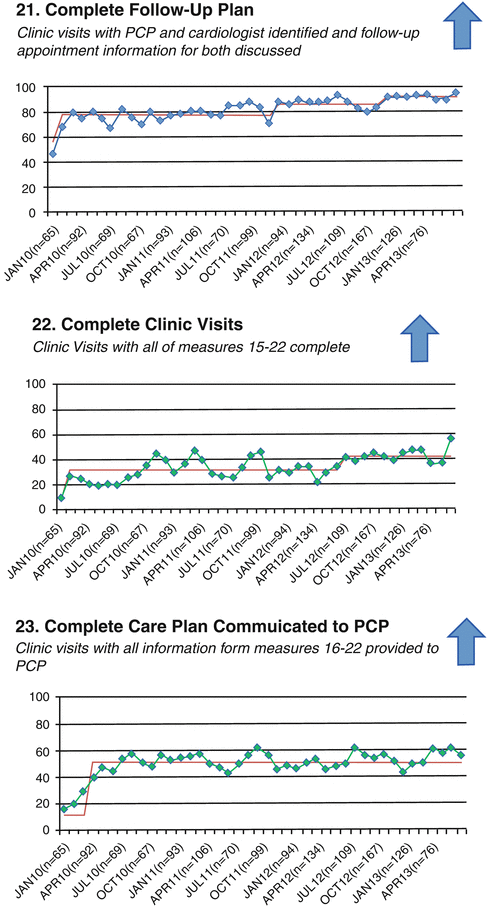






Fig. 4.5
NPC-QIC discharge and clinic visit process measures
The elimination and attenuation of growth failure in this population is one of the primary outcomes of the collaborative. Analysis of growth outcomes identified significant variation in outcomes among the NPC-QIC centers [49]. This analysis determined that there were specific nutritional practices that are being used by centers that had better patient growth. These practices, when combined as a Nutritional Bundle resulted in significantly better interstage infant growth. This growth bundle included: (1) Standard evaluation of each infant prior to discharge after the Norwood procedure for any feeding dysfunction; (2) Providing families with home scales to monitor daily weight gain in the interstage phase; (3) Weekly contact with families to review interstage growth by phone/email; (4) Specific weight change “red flags” to catch growth faltering early and allow for nutritional intervention; and (5) A Dietician available for consultation, either in person or by phone, at all interstage outpatient visits. This Nutritional Bundle was provided to the NPC-QIC teams and has demonstrated great improvement in the weight and well being of these children.
The NPC-QIC brought together a Nutrition Working Group. This group comprised dieticians, nurses, speech therapists and physicians from twelve NPC-QIC sites. The Nutrition Working Group performed an extensive literature review and created algorithms for the feeding of single ventricle infants prior to Norwood, post-operatively after Norwood and in the outpatient interstage [50]. The purpose of these algorithms was to move towards reducing practice site variation by standardization of nutrition management.
Future Directions
The NPCQIC currently comprises 46 sites and includes the largest children’s hospitals in the US, and almost all programs that perform complex congenital heart surgeries. The NPCQIC is achieving its objectives to (1) build a sustainable collaborative network of multidisciplinary pediatric cardiology teams, engaged parent partners, and scientists; and (2) use a registry to support improvement in care delivery and research projects resulting in improved survival and outcomes of infants with HLHS in the high-risk interstage. As of July 2013, the NPCQIC has amassed data from 1,000 infants in the registry, with data accrued from over 4,000 clinic visits, 1,300 readmissions and from 83 deaths.
The NPCQIC collaborative infrastructure has recently evolved to include a research subcommittee as well as a formal governance structure, consisting of seven cardiologists, five parents, a QI liaison, and three members with business expertise. Current financial support includes a 5-year grant from the Children’s Heart Association of Cincinnati, participation fees from participating sites, and in-kind support for meetings from the Heart Institute of CCHMC. Previous support has included targeted project support from state and national. Grants.
The NPC-QIC has documented significant improvement in care process measures and has begun to see improvement in primary outcome measures as well. There have been single sites that have begun to show significant improvement in growth of their infants and the collaborative has seen periodic improved process measures by reducing the average time between child readmissions for major events. However, we recognize that there has been less than expected improvement in outcome measures, given the significant improvement in process measures. The collaborative has formed three multi-institution working groups in order to move to the next steps of understanding the primary outcomes including a Mortality Working Group, Readmission Working Group, and is reconvening the Nutrition Working Group. The aim of these working groups will be to determine additional information that needs to be gathered, including directly from families, define more precise metrics, and identify strategies that result in improved outcomes.
Conclusions
The National Pediatric Cardiology Quality Improvement Collaborative (NPC-QIC) is the first U.S. quality improvement collaborative in pediatric cardiology. The NPC-QIC is evolving towards the Learning Health System model described by the Institute of Medicine, in which patients, clinicians, researchers, and other stakeholders collaborate in a meaningful partnership to improve outcomes and generate new knowledge, and in which health care, health care improvement, and research are purposefully integrated [51, 52]. The NPC-QIC has successfully used a multi-site network, practice-based registry data and improvement science methodology to identify variation in management and to improve outcomes in patients with complex congenital heart disease. The NPC-QIC has seen significant improvement in process measures across participating centers and is beginning to see improvement in outcome measures. The Learning Health System model, exemplified by NPCQIC’s collaborative effort, is vital to the field of pediatric cardiology, and for other clinical fields which care for patients with rare disorders [53].
References
1.
Darst JR, Newburger JW, Resch S, Rathod RH, Lock JE. Deciding without data. Congenit Heart Dis. 2010;5(4):339–42.PubMedCrossRef
< div class='tao-gold-member'>
Only gold members can continue reading. Log In or Register to continue
Stay updated, free articles. Join our Telegram channel

Full access? Get Clinical Tree


